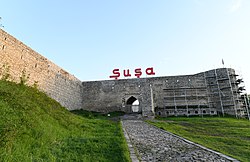By city
Agdam
On 20 November 2020, the city of Aghdam and its surrounding district were returned to Azerbaijan as part of the ceasefire agreement. [14] Plans were announced to construct a 44.5-kilometer-long highway linking Agdam to the city of Barda. [15] On 28 May 2021, President Aliyev laid the foundation stone for the project. [16]
Fuzuli

On 16 November 2020, the foundation stone for the construction of a highway linking the cities of Fuzuli and Shusha was laid. [17] The highway was planned to integrate into a wider scheme to construct a highway to the municipality of Ahmadbeyli. Plans indicate that the road would be 101.5 km in length and 37.7m wide. [18] On 26 October 2021, Fuzuli International Airport was inaugurated. Turkish companies constructed the airport [19] at a cost of 75 million manats ($44 million). [20] [21] [22] The first flight test to the airport took place on August 22, 2021. [23]
Hadrut
Construction works in Hadrut, which came under Azerbaijan's control on October 9, 2020, [24] began with the restoration of roads. On March 15, 2021, President Aliyev laid the foundation for the Fuzuli–Hadrut highway with a length of 13 km. [25] [26] . It has been noted that the Hadrut–Jabrayil–Shukurbayli, which passes through Jabrayil District, will be connected to the Hajigabul–Minjivan–Zangazur highway in Shukurbeyli. The road, which is planned to be 43 km in length, will have 4 lanes and road bridges built along. [25] Moreover, it was reported that the construction of the 18-kilometer-long Tugh–Hadrut highway was underway. [27]
Kalbajar

On 23 July 2021, construction began on the construction of a highway linking Toganali, Istisu and Kalbajar. The 81-kilometer long highway would connect Goygol District and Kalbajar District. [28]
On 16 August 16, 2021, the foundation stone for the Murovdag tunnel was laid. The tunnel will form part of an 11.6-kilometer highway. [29]
On 16 August 16, 2021, the foundation stone for a 3.4-kilometer-long tunnel was laid. It is planned that the tunnel will be a part of a 72.8-kilometer-long highway that is intended to link Kalbajar with Lachin. [30] A second connection between Kalbajar and Lachin districts is also planned - the Istisu–Minkend road. [31]
Lachin
Lachin International Airport, is an airport under construction in Lachin, Azerbaijan. The construction of the airport began in May 2021 and is expected to be completed in 2024. It will be the highest altitude airport in Azerbaijan at 1,700-1,800 meters above sea level.
Qubadli
On 25 October 2021, the foundation stone for a highway connecting Khanlig and Qubadli was laid and a substation of Azerenerji in Qubadli was opened. [32] On the same day, a 50-meter-high radio and television broadcasting tower was erected in Khanlig village. [33] Two 76-kilometer-long power lines (Qubadli-1 and Qubadli-2) were installed from Shukurbayli and Jabrayil substations to connect Qubadli to the general energy system of Azerbaijan. [34]
Shusha

Following Azerbaijan taking control of the city in the Battle of Shusha and the subsequent end of the war, Azerbaijan's government embarked on a major construction plan to restore the city, attracting substantial criticism including due to a lack of transparency. Some former Azerbaijani residents of the city also expressed discontent with the demolition of buildings due to them wanting to return to their homes as well as due to their opinions not being taken into consideration. [35] Among the buildings being demolished were those constructed by the Armenian authorities while they controlled the city, including a new parliament building, apparently in order to make room for the construction of a mosque. [36]
In January 2021, plans were announced for the construction of a five-star hotel in the city of Shusha. [37] Restoration of the Shusha fortress began in early February 2021. [38]
In early May 2021, the government announced that it would commence repairs to Ghazanchetsots Cathedral which was twice struck with missiles by the Azerbaijaini military during the 2020 war. [39]
In early June 2021, it was announced that three mosques in Shusha — Ashagi Govhar Agha, Yukhari Govhar Agha and Saatli — would be restored by the Heydar Aliyev Foundation. [40] On June 22, the "Shusha City State Reserve Department" was established. [41]
On January 14, 2021, restoration works began on Vagif Mausoleum [42] and it was opened on August 29. [43]
Zangilan

On 14 February 14, 2021, the foundation stone of a railway line linking Horadiz, Zangilan and Agband was laid. In making the announcement, the President stated that was intended that the branch would connect Azerbaijan proper with the exclave of the Nakhchivan Autonomous Republic. [44] [45] It was not mentioned how such a line would traverse the territory of the Republic of Armenia.
On March 18, 2021, the "Brotherhood Garden" was opened in Agali village by delegations from the Turkish Ministerty of Agriculture and Forestry (Bekir Pakdemirli) and the Azerbaijani the Ministry of Agriculture of Azerbaijan. [46]
On 1 May 2021, plans were announced for the construction of the Zangilan International Airport. [47]
On 20 October 2021, the President signed an order to make an inventory of natural objects in the Basut-Chay State Reserve and to assess the environmental situation. [48]
On 26 October 2021, the Presidents of Azerbaijan and Turkey announced plans to found an agro-park -"Dost" - to be constructed with the support of Turkey. [49] [50]
On 19 July 2022, the first residents returned to Ağalı village after 29 years. The village has a school, post office, health centre, bank, market and cafe. It is expected that 1300 people will live in the village [51]
On 21 October 2022, Zangilan International Airport was inaugurated by President Aliyev of Azerbaijan and President Erdoğan of Turkey [52]